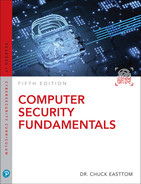Table of Contents
Chapter 1: Introduction to Computer Security
Chapter 2: Networks and the Internet
Chapter 3: Cyber Stalking, Fraud, and Abuse
Chapter 4: Denial of Service Attacks
-
Chapter 6: Techniques Used by Hackers
Chapter 7: Industrial Espionage in Cyberspace
-
Chapter 9: Computer Security Technology
-
Chapter 11: Network Scanning and Vulnerability Scanning
Chapter 12: Cyber Terrorism and Information Warfare
Chapter 14: Introduction to Forensics
Chapter 15: Cybersecurity Engineering
..................Content has been hidden....................
You can't read the all page of ebook, please click here login for view all page.
